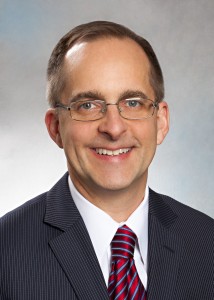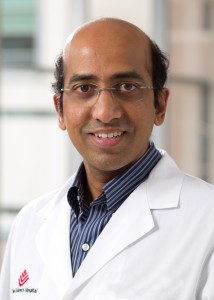Accurate medical 3D printing begins with advanced 3D visualization, but economic concerns will shape its adoption by radiologists and imaging practices.
By Lena Kauffman
A baby’s life saved with a custom 3D-printed tracheal implant that over time will absorb into the body. It sounds like science fiction and made headlines across the nation when it was first used in an operation at the University of Michigan C.S. Mott Children’s Hospital in 2012. However, the procedure, which has since been performed on two more babies, is just the tip of the iceberg in this emerging field intimately tied to advanced 3D visualization and radiology.
Scott Hollister, PhD, professor of Biomedical Engineering and Mechanical Engineering at the University of Michigan, helped develop the technique used to create the tiny 3D printed splint that was placed around the trachea of Kaiba, the first baby with tracheobronchomalacia treated in this way. However, the splint is not even the most exciting 3D printing medical application within his own department. He also directs the Scaffold Tissue Engineering Group, which along with researchers at Stanford, Wake Forest, Georgia Tech, and the University of Pittsburgh, is working on growing new organ tissues on custom 3D printed biodegradable scaffolds.
Of course, this is all happening in the realm of advanced clinical research because reimbursement for 3D printing in clinical applications is largely absent. For most radiologists, 3D printing and how it may tie in with the field of medical imaging is a fascinating but still fairly remote part of their future, said Frank J. Rybicki, MD, PhD, FAHA, director of the Applied Imaging Science Laboratory at Brigham and Women’s Hospital and Harvard Medical School in Boston.
Rybicki is one of the most knowledgeable radiologists currently involved in 3D printing because he also works with the 3D Medical Applications Center at Walter Reed National Military Medical Center in Bethesda, Md. At Walter Reed, five different types of printers are used in combination with more than 50 different materials to create one of the broadest ranges of custom 3D-printed surgical models and implants found anywhere in the world. He predicted that while radiologists will definitely be the ones doing 3D printing in the future because they are the ones who create Digital Imaging and Communications in Medicine (DICOM) 3D visualizations, individual practices will likely offer 3D prints only in the most commonly requested materials printed on one or two different types of printers. Academic centers and specialists in 3D printing may handle more rare or complex 3D printing needs.
“[At Walter Reed] we’ve printed everything with every possible material,” Rybicki said. “That is fine for the government, but that is not a practical practice model. If I am selling sweaters, I’m not necessarily going to carry sweaters made out of rare alpaca wool just because someone might prefer an alpaca sweater. I’ll probably just carry wool sweaters, cotton sweaters, and maybe cashmere sweaters.”
According to Rybicki, rigid models will probably eventually come in one or two types with a slightly larger palate of flexible model materials for the printing of soft tissues, such as hearts. It is hard to predict exactly which materials, which printers, and when practices may begin 3D printing, however, because a great deal depends on when payors will determine that there is incremental value in this technology over current 3D computer visualizations of anatomy.
“Radiologists need to be aware of the process of getting 3D printing eventually reimbursed and be familiar with 3D models so that when [reimbursement happens], they are ready,” Rybicki said. “They already have 3D visualization and then they can upgrade that 3D visualization to a 3D printing regime where they can actually deliver the models to their referring physicians.”
According to Rybicki, the added training necessary for a radiologist to begin 3D printing from DICOM 3D visualizations is not too hard to acquire. He led five well-attended hands-on sessions on 3D printing at RSNA, in addition to giving lectures. This shows that radiologists are indeed being smart and becoming better informed about the technology, he said.
Furthermore, purchasing the software, printers, and materials necessary to begin 3D printing from DICOM images is a modest investment compared to buying a new MR, CT, or even some high-end ultrasound systems. The challenge is lack of reimbursement.
“It is not like the capital expenses are huge,” Rybicki said. “A 3D printer is not big box technology, and 3D printers get cheaper every day.”
Practical 3D Printing Today
At present, the majority of clinical applications for 3D printing are in maxillofacial disease even though cardiac and pediatric applications tend to get more news coverage. “Probably 50% or more of all 3D printed models that have been used in practice are for bone reconstruction, particularly tricky things in the face,” Rybicki said. “That is where bread-and-butter 3D printing is now.”
Academic and specialty hospitals with advanced imaging processing labs are also expanding into printing 3D models for surgical planning purposes, even though they must absorb the cost of the printing in the overall cost of the surgery. Texas Children’s Hospital in Houston is an example of one such institution.
Rajesh Krishnamurthy, MD, director for research and the cardiovascular imaging program at Texas Children’s Hospital’s EB Singleton Department of Pediatric Radiology, said that 3 years ago, the hospital began printing simpler rigid models of bones in orthopedic disorders as a curiosity. However, the orthopedic surgeons soon found that these models were very useful in planning complex procedures such as hip dysplasia surgeries, where avoiding critical structures like growth plates could improve patients’ outcomes.
Because Texas Children’s had one of the world’s top pediatric cardiac imaging programs, they then turned their attention toward printing a few complex hearts to look at the intracardiac anatomy, Krishnamurthy explained. This led to 3D printing models for surgical planning in certain cases of ventricular septal defect (VSD), a common congenital heart defect where there is a hole in the wall that separates the heart’s lower chambers and allows blood to pass from the left to the right side of the heart.
“[In VSD cases], they are typically trying to decide if somebody can keep both ventricles or if they have to go down to a single ventricle pathway,” Krishnamurthy explained. “That is a huge decision point, and we realized that printing the inside of the heart and showing the relationship of the opening of the heart to the aorta could actually help the surgeons decide if it was feasible or not to keep both ventricles.”
Because there is always a risk of artifacts (false data) in imaging, 3D models are never the only reference surgeons use at Texas Children’s. They also compare the 3D-printed model to computer 3D visualizations and the raw data, Krishnamurthy said. However, the models reduce the chance that there will be a surprising finding once the surgery begins and facilitate better collaboration with the full care team in surgery planning. This in turn can reduce procedure time, potentially saving money and improving outcomes.
“Surgeons who know what they are doing are very conversant with the raw data and no surgeon would trust just a 3D model because errors can creep in,” he said. “However, increasingly these complex procedures require a multidisciplinary team, and although the surgeon has enough experience to comprehend the anatomy by just looking at the raw data, just the simple matter of printing the anatomy and sharing it with the team can make the procedures go so much more smoothly.”
Texas Children’s Hospital currently prints models out of two materials, a cheaper rigid material that costs $50 to $100 per print and a more expensive soft material that costs 10 to 20 times as much and can take up to 2 days to print out on its dual-head extrusion 3D printer.
The hospital produces around 100 3D-printed models per year, with about half being for research and the other half for clinical applications, such as surgical planning. The majority of the models are the inexpensive rigid kind, according to Krishnamurthy, because unless there is research funding for the model, the hospital must absorb the full cost of creating it, including all the staff time and expertise necessary.
They do use the more costly soft model in some cases, however, because it can be manipulated like real tissue to reveal internal structures. In addition, unlike the rigid model, it is sturdy enough to survive being sterilized and can therefore be taken into the operating room for use as a reference during the surgery.
“There is a very high level of curiosity [from our physicians] and a high level of expectation that this should be done in cases where it would very obviously impact the outcome,” Krishnamurthy said. “Unfortunately, the reimbursement issues are a big deterrent. We absolutely have to solve the reimbursement problem for it to be made available to all the patients who could benefit from it.”
Proving 3D Printing’s Value
Because of the costs involved, Texas Children’s Hospital is very selective in which cases it uses 3D printed models. As a result, the anecdotal benefit of the technology is plentiful, but the actual large data sets on outcomes to prove objectively that there is a benefit are almost nonexistent. This is true even when multiple institutions pool their data.
“Anecdotally, we clearly see an impact on those cases because we know going in that these are the highly complex cases that could benefit from this type of perspective,” Krishnamurthy said. “But when you take such a low-volume field as 3D printing and expect to demonstrate impact on outcomes or lowering hospital stay, that is a far reach at this point. For that to happen, 3D printing must become so commonplace that we were doing it on all cases.”
Of course, the other component of 3D printing’s acceptance as a valuable service comes from demand by patients and clinicians. Offering 3D printing could be a competitive advantage for large academic medical centers, especially those connected to university engineering departments that may already have invested in 3D printers, software, and materials for research purposes.
“Academic medical centers that have good collaborations or have engineering colleges on site will start to set up their own 3D printing centers to make custom implants, and they will be able to treat initially very customized and very specialized reconstructive cases,” said Hollister. “My feeling is that most of the large academic medical centers will pursue that and those that don’t pursue it will be left behind. It will be the type of technology where patients will know that they have the choice between going to Center A that doesn’t have a 3D printing center and Center B where they can get a personalized customized implant for a specialized condition, and obviously they are going to go to Center B.”
Academic centers where engineers, clinicians, and researchers collaborate also have a leg up in 3D printing because they have the resources to develop new methods for creating more types of 3D models and implants. In addition, they typically have the relationships and experience necessary to get fast-tracked approvals for new technologies from government oversight agencies such as the US Food and Drug Administration.
Radiologist-Led Outsourced 3D Printing
But don’t count radiologist-led programs out yet. Radiologists do have some advantages over engineers, and Hollister predicts that they will eventually do the bulk of hospital 3D printing, especially for surgical models.
The radiologists’ advantage is that they understand the initial acquisition of the images best and can watch for artifacts in the images, such as those created by movement during pediatric scanning, explained Shi-Joon Yoo, MD, a Toronto pediatric radiologist who was an early adopter of 3D printing.
One possible business model for how radiologists can help make 3D printing more accessible is exemplified by 3D Hope, the company Yoo founded in 2009 to provide 3D-printed surgical planning and education tools to his colleagues at the Hospital for Sick Children in Toronto.
According to Yoo, the economic considerations for 3D printing include the quality of the printer and the volume of prints needed. The prints need to be high quality enough to let surgeons gain a better understanding of the anatomy being printed than they could get from just a computer 3D visualization. However, they also need to be reasonably affordable, so there is a cost versus quality balance that must be worked out.
Volume relates to the economic justification for buying your own higher-end printer and setting up an in-house 3D printing lab. Although Yoo consults with many institutions each year on the feasibility of in-house radiologist-led 3D printing, it is rare to have a single institution with enough 3D printing needs to justify a dedicated program.
“If you want to run the program, you need to have a certain number of cases,” he said. “If the investment is $1 million, you really should have a thousand cases to do per year to sustain the program. You invested a million and the manpower you need might be $200,000 and you only have 20 cases in a year. That means you can’t run the program. This program should not be in every institution.”
Like Texas Children’s Hospital, Yoo’s company uses an extrusion printer to create both hard and flexible 3D models for surgical planning. However, unlike Texas Children’s, 3D Hope provides models for institutions around the world. In addition, it keeps a library of imaging studies on heart defects and sells models printed from these studies for use in surgical training programs.
3D Printing and Patient-Centered Medicine
The potential for 3D printing in creating new customized treatments, improving surgical training, and making surgeries faster and safer is considerable, but there is one final benefit of 3D printing and that is in enhancing the patient’s understanding of a complex procedure. If 3D-printed models eventually become inexpensive enough, there could be a market for radiologists in printing simpler models just for ordering physicians to use in care planning with patients. Krishnamurthy said that he has found a tremendous difference between explaining a procedure with images on a screen and with a custom life-size model of the patient’s actual anatomy.
“I think it is unconscionable that insurance companies don’t recognize that need and don’t reimburse purely for that purpose today because it just makes a huge difference not only to patient comprehension but also to the care team’s comprehension of the procedure,” he said.
While actual payment may be a ways off, the fast-moving field of 3D printing certainly bears watching. “There is no doubt 3D printing will be a part of radiology practices in the future,” Rybicki concluded. “It is just a matter of time to figure out where it will all hit.”
####
Lena Kauffman is a contributing writer for AXIS.








